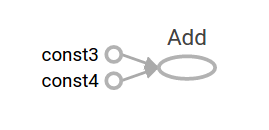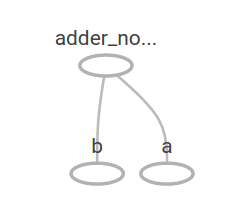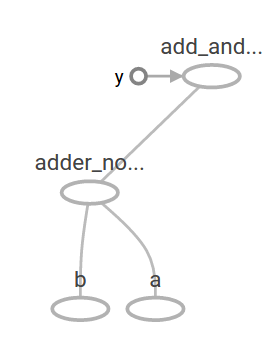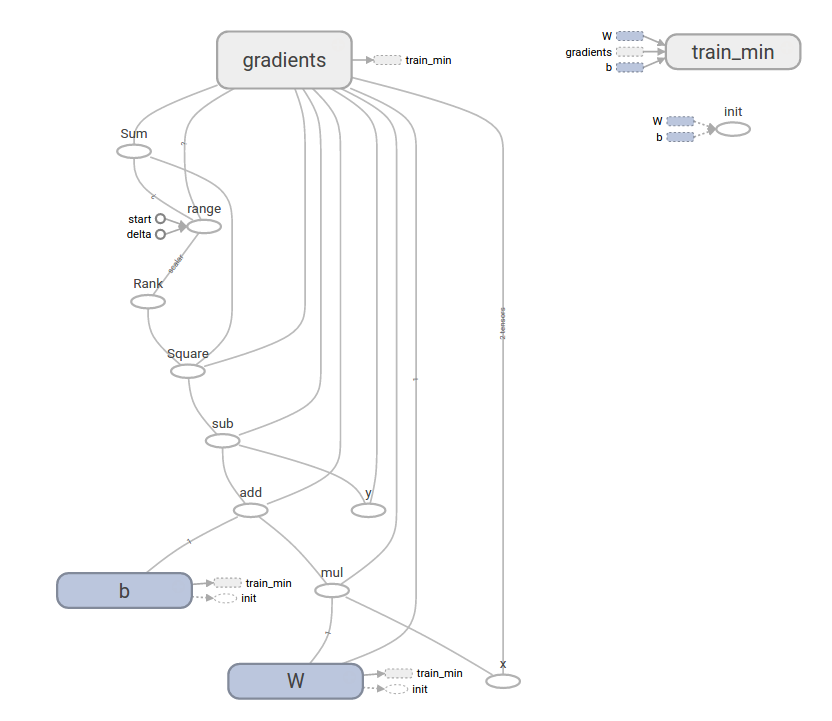Tensors
tensorflow中核心数据单元是tensor张量。张量是一组任意维度的值。张量的rank是维度的数量。
- 3 # a rank 0 tensor; a scalar with shape []
- [1., 2., 3.] # a rank 1 tensor; a vector with shape [3]
- [[1., 2., 3.], [4., 5., 6.]] # a rank 2 tensor; a matrix with shape [2, 3]
- [[[1., 2., 3.]], [[7., 8., 9.]]] # a rank 3 tensor with shape [2, 1, 3]
TensorFlow Core tutorial
Importing TensorFlow
import tensorflow as tf
import tensorflow as tf
The Computation Graph
tensorflow核心程序包括两部分:
1.构建计算图
2.运行计算图
计算图是由一系列tensorflow操作组成,这些操作就是图中的节点。构建一个简单的计算图,每个节点的输入是零个或多个张量,输出是生成的一个张量。节点的类型之一是常量。常量不需要输入,输出是内部存储值。
node1=tf.constant(3.0,dtype=tf.float32) node2=tf.constant(4.0) print(node1,node2)
注:打印节点没有输出3.0和4.0,是因为目前它们只是节点,在实际评估节点时,需要使用session运行图,才能打印出3.0和4.0。session封装了tensorflow运行时的控制和状态。
创建一个Session对象,然后调用run方法,运行计算图来评估node1和node2。
sess=tf.Session() print(sess.run([node1,node2]))
[3.0, 4.0]
更加复杂的计算,例如将两个常量节点相加
node3=tf.add(node1,node2) print(node3) print(sess.run(node3))
Tensor("Add_2:0", shape=(), dtype=float32)
7.0

除此之外图可以接受外部输入,即占位符,占位符是允许在之后再赋值。
a=tf.placeholder(tf.float32) b=tf.placeholder(tf.float32) adder_node=a+b
类似函数,定义了两个输入参数a和b,以及它们之间的操作,可以通过多次输入评估这个图,通过使用feed_dict:
print(sess.run(adder_node,{a:3,b:4.5}))
7.5

再复杂一些
add_and_triple=adder_node*3 print(sess.run(add_and_triple,{a:3,b:4.5}))

机器学习中需要能够通过修改图,达到相同输入得到不同输出,变量就可以在图中加入可训练参数,变量由类型和初始值构成。
W=tf.Variable([.3],dtype=tf.float32) b=tf.Variable([-.3],dtype=tf.float32) x=tf.placeholder(tf.float32) linear_model=W*x+b
常量实在调用tf.constant时被初始化,值不会再改变。而变量在调用tf.Variable是没有被初始化,需要调用具体操作:
init=tf.global_variables_initializer()
sess.run(init)
print(sess.run(linear_model,{x:[1,2,3,4]}))
[ 0. 0.30000001 0.60000002 0.90000004]
为了评估模型好坏,需要损失函数。
损失函数用于衡量当前模型与提供的结果的差距。使用线性回归的标准损失函数模型。
y=tf.placeholder(tf.float32) squared_deltas=tf.square(linear_model-y) loss=tf.reduce_sum(squared_deltas) print(sess.run(loss,{x:[1,2,3,4],y:[0,-1,-2,-3]}))
23.66
fixW=tf.assign(W,[-1.]) fixb=tf.assign(b,[1.]) sess.run([fixW,fixb]) print(sess.run(loss,{x:[1,2,3,4],y:[0,-1,-2,-3]}))
0.0
tf.train API
tensorflow提供optimizers慢慢地改变变量来使损失函数最小化。最简单的优化是梯度下降。
optimizer=tf.train.GradientDescentOptimizer(0.01) train=optimizer.minimize(loss) sess.run(init) for i in range(1000): sess.run(train,{x:[1,2,3,4],y:[0,-1,-2,-3]}) print(sess.run([W,b]))
[array([-0.9999969], dtype=float32), array([ 0.99999082], dtype=float32)]
完整程序
import tensorflow as tf # Model parameters W = tf.Variable([.3], dtype=tf.float32) b = tf.Variable([-.3], dtype=tf.float32) # Model input and output x = tf.placeholder(tf.float32) linear_model = W*x + b y = tf.placeholder(tf.float32) # loss loss = tf.reduce_sum(tf.square(linear_model - y)) # sum of the squares # optimizer optimizer = tf.train.GradientDescentOptimizer(0.01) train = optimizer.minimize(loss) # training data x_train = [1, 2, 3, 4] y_train = [0, -1, -2, -3] # training loop init = tf.global_variables_initializer() sess = tf.Session() sess.run(init) # reset values to wrong for i in range(1000): sess.run(train, {x: x_train, y: y_train}) # evaluate training accuracy curr_W, curr_b, curr_loss = sess.run([W, b, loss], {x: x_train, y: y_train}) print("W: %s b: %s loss: %s"%(curr_W, curr_b, curr_loss))

tf.estimator
tf.estimator是tensorflow的高级库,简化机器学习,主要包括:
- 循环训练的运行
- 循环评估的运行
- 管理数据集
基本使用
可以看出更加简洁:
import tensorflow as tf import numpy as np #特征的声明列表 feature_columns=[tf.feature_column.numeric_column("x",shape=[1])] #estimator是调用训练和评估的前端。有许多与定义类型例如线性回归,线性分类,神经网络分类和回归。 estimator=tf.estimator.LinearRegressor(feature_columns=feature_columns) x_train = np.array([1., 2., 3., 4.]) y_train = np.array([0., -1., -2., -3.]) x_eval = np.array([2., 5., 8., 1.]) y_eval = np.array([-1.01, -4.1, -7, 0.]) input_fn=tf.estimator.inputs.numpy_input_fn({"x":x_train},y_train,batch_size=4,num_epochs=None,shuffle=True) train_input_fn=tf.estimator.inputs.numpy_input_fn({"x":x_train},y_train,batch_size=4,num_epochs=1000,shuffle=False) eval_input_fn = tf.estimator.inputs.numpy_input_fn({"x": x_eval}, y_eval, batch_size=4, num_epochs=1000, shuffle=False) #调用1000次训练 estimator.train(input_fn=input_fn,steps=1000) #评估模型好坏 train_metrics=estimator.evaluate(input_fn=train_input_fn) eval_metrics=estimator.evaluate(input_fn=eval_input_fn) print("train metrics: %r"% train_metrics) print("eval metrics: %r"% eval_metrics)





















 159
159

 被折叠的 条评论
为什么被折叠?
被折叠的 条评论
为什么被折叠?








